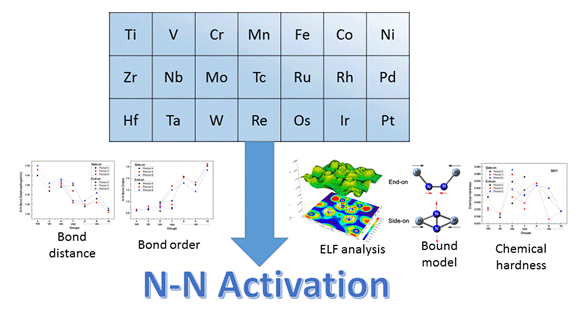| [1] Tanabe, Y.; Nishibayashi, Y. Coord. Chem. Rev. 2013, 257, 2551.
[2] Ma, X. L.; Lei, M. Prog. Chem. 2013, 25, 1325. (马雪璐, 雷鸣, 化学进展, 2013, 25, 1325.)
[3] Dance, I. Z. Anorg. Allg. Chem. 2014, 91.
[4] McKee, M. L. J. Comput. Chem. 2007, 28, 1796.
[5] Fryzuk, M. D. Science 2013, 340, 1530.
[6] Hoffman, B. M.; Lukoyanov, D.; Dean, D. R.; Seefeldt, L. C. Acc. Chem. Res. 2013, 46, 587.
[7] Barney, B. M.; Lukoyanov, D.; Yang, T.-C.; Dean, D. R.; Hoffman, B. M.; Seefeldt, L. C. Proc. Natl. Acad. Sci. U. S. A. 2006, 103, 17113.
[8] Hoffman, B. M.; Lukoyanov, D.; Yang, Z.-Y.; Dean, D. R.; Seefeldt, L. C. Chem. Rev. 2014, 114, 4041.
[9] Holland, P. L. Dalton Trans. 2010, 39, 5415.
[10] Cavigliasso, G.; Wilson, L.; McAlpine, S.; Attar, M.; Stranger, R.; Yates, B. F. Dalton Trans. 2010, 39, 4529.
[11] Gambarotta, S.; Scott, J. Angew. Chem. Int. Ed. 2004, 43, 5298.
[12] Mori, M. J. Organomet. Chem. 2004, 689, 4210.
[13] Fryzuk, M. D. Acc. Chem. Res. 2009, 42, 127.
[14] Fryzuk, M. D.; Johnson, S. A. Coord. Chem. Rev. 2000, 200-202, 379.
[15] Hinrichsen, S.; Broda, H.; Gradert, C.; Soncksen, L.; Tuczek, F. Annu. Rep. Prog. Chem. Sect. A: Inorg. Chem. 2012, 108, 17.
[16] van der Ham, C. J. M.; Koper, M. T. M.; Hetterscheid, D. G. H. Chem. Soc. Rev. 2014, 43, 5183.
[17] (a) Chatt, J.; Dilworth, J. R.; Richards, R. L. Chem. Rev. 1978, 78, 589.
(b) Hidai, M.; Uchida, Y.; Tominari, K. J. Am. Chem. Soc. 1972, 94, 110.
[18] Yandulov, D. V.; Schrock, R. R. Science 2003, 301, 76.
[19] Kazuya, A.; Yoshihiro, M.; Yoshiaki, N. Nature Chem. 2011, 3, 120.
[20] Anderson, J. S.; Rittle, J.; Peters, J. C. Nature 2013, 501, 84.
[21] MacLeod, K. C.; Holland, P. L. Nature Chem. 2013, 5, 559.
[22] Chen, Y.; Zhou, Y.; Chen, P.; Tao, Y.; Li, Y.; Qu, J. J. Am. Chem. Soc. 2008, 130, 15250.
[23] Li, Y.; Li, Y.; Wang, B.; Luo, Y.; Yang, D.; Tong, P.; Zhao, J.; Luo, L.; Zhou, Y.; Chen, S.; Cheng, F.; Qu, J. Nature Chem. 2013, 5, 320.
[24] Sproules, S.; Wieghardt, K. Coord. Chem. Rev. 2010, 254, 1358.
[25] Felton, G. A.; Vannucci, A. K.; Chen, J.; Lockett, L. T.; Okumura, N.; Petro, B. J.; Zakai, U. I.; Evans, D. H.; Glass, R. S.; Lichtenberger, D. L. J. Am. Chem. Soc. 2007, 129, 12521.
[26] Muratsugu, S.; Sodeyama, K.; Kitamura, F.; Sugimoto, M.; Tsuneyuki, S.; Miyashita, S.; Kato, T.; Nishihara, H. J. Am. Chem. Soc. 2009, 131, 1388.
[27] Luo, Y.; Li, Y.; Yu, H.; Zhao, J.; Chen, Y.; Hou, Z.; Qu, J. Organometallics 2011, 31, 335.
[28] Liu, C.; Hua, J.; Lu, J. Acta Chim. Sinica 1988, 46, 315. (刘春万, 华建民, 卢嘉锡, 化学学报, 1988, 46, 315.)
[29] Tyler, D. R. Z. Anorg. Allg. Chem. 2014, 31.
[30] Bobadova-Parvanova, P.; Wang, Q.; Morokuma, K.; Musaev, G. D. Angew. Chem. 2005, 117, 7263.
[31] Becke, A. D. J. Chem. Phys. 1993, 98, 5648.
[32] Lee, C.; Yang, W.; Parr, R. G. Phys. Rev. B 1988, 37, 785.
[33] Frisch, M. J.; Trucks, G. W.; Schlegel, H. B. Gaussian 09, Revision B. 01. Gaussian, Inc, Wallingford, 2010.
[34] Lu, T.; Chen, F. J. Comput. Chem. 2012, 33, 580.
[35] Ma, X.; Tang, Y.; Lei, M. Dalton Trans. 2014, 43, 11658.
[36] Ma, X.; Lei, M.; Liu, S. Organometallics 2015, 34, 1255.
[37] Ma, X.; Zhang, X.; Zhang, W.; Lei, M. Phys. Chem. Chem. Phys. 2013, 15, 901.
[38] Wang, M.; Zhang, X.; Chen, Z.; Tang, Y.; Lei, M. Sci. China Chem. 2014, 57(9), 1264.
[39] Ma, J.; Li, R.; Ren, K.; Ma, X.; Zhu, K.; Geng, Z. Acta Chim. Sinica 2015, 73, 431. (马军, 李榕, 任馗玮, 马禧龙, 朱开礼, 耿志远, 化学学报, 2015, 73, 431.)
[40] Liu, S. B.; Rong, C. Y.; Wu, Z. M.; Lu, T. Acta Phys. -Chim. Sin. 2015, 31, 2057. (刘述斌, 荣春英, 吴泽民, 卢天, 物理化学学报, 2015, 31, 2057.) |
